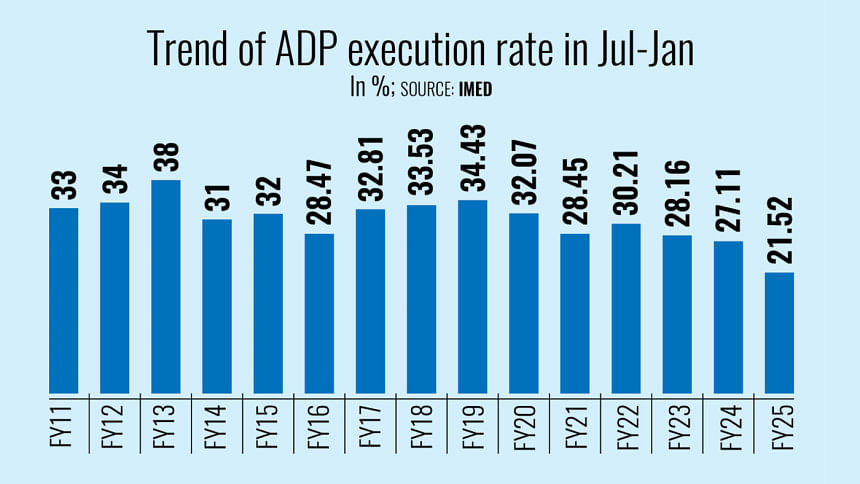Development spending in Jul-Jan hits 15-year low

Implementation of the Annual Development Programme (ADP) stood at just 21.52 percent in the first seven months of fiscal year 2024-25 as public works were weighed down by political unrest.
Besides, there were prolonged delays in implementing projects that were approved by the past government.
This was the lowest ADP implementation in roughly the past 15 years, including the same seven months of fiscal year 2020-21, when the Covid-19 pandemic was raging across the globe.
The ADP comprises projects and associated allocations based on each fiscal year's parliament-approved development budget.
According to data of the Implementation Monitoring and Evaluation Division under the planning ministry, development spending stood at Tk 59,877 crore in the July-January period.
Meanwhile, it was Tk 74,464 crore during the same months of the preceding fiscal year, representing more than 27 percent of the total allocation available.
Last month, Tk 9,874 crore (3.55 percent) was spent by the government agencies.
In comparison, Tk 12,725 crore (4.63 percent) was spent in the same month last year.
"Implementation of the ADP has increasingly weakened over time, with an average of only 78 percent of budgeted funds utilised over the last decade," said Ashikur Rahman, principal economist at the Policy Research Institute of Bangladesh.
In FY24, ADP implementation fell further to 72 percent due to political uncertainties associated with the national election in January 2024, inefficiencies and funding constraints.
"The recent political unrest, mob violence and an unsettled state of bureaucratic machinery have caused additional delays and cancellations in public programmes," he added.
Rahman also cited a lack of coherence and coordination among government agencies.
"This state of affairs underscores a lack of coherence among different government agencies, and it also highlights the necessity to improve coordination and focus on additional revenue mobilisation," he said.
This less than encouraging state of ADP implementation means that GDP growth in FY25 is expected to remain stagnant if things do not improve significantly over the next four months, but that looks very unlikely.
Furthermore, low government spending contributes to low revenue collection, as cited by officials of the National Board of Revenue who frequently blame slow growth in the construction sector, he added.
By the end of the first half of the current fiscal year, the tax authority was around 25 percent behind its required revenue collection target.
Last month, Planning Adviser Wahiduddin Mahmud said the pace of ADP implementation slowed this year because the government needed to scrutinise and amend many projects in the first few months, which was quite time consuming.
"Now, we have accelerated the scrutiny," he told journalists following a meeting of the Executive Committee of the National Economic Council in January.
Mahmud, also a noted economist, expressed hope that ADP implementation would pick up in coming months as less verification would be required for several new projects that are aligned with priorities of the current administration.
Amid the absence of parliament members and the fragile state of local governments, temporary administrators appointed by the government are managing local governance, and their demand for new projects has been minimal.
"I have urged local officials to submit project proposals, and the Planning Commission is also analysing the needs of the people while approving new projects," Mahmud added.
Among public offices with the highest allocations, the Health Services Division utilised the lowest portion of its funds, with just 5.15 percent having been spent during the last seven months.
The Ministry of Science and Technology spent the most, utilising 36.55 percent of its allocation, followed by Power Division with 33.64 percent, Local Government Division with 29.63 percent, and Ministry of Agriculture with 25 percent.

 For all latest news, follow The Daily Star's Google News channel.
For all latest news, follow The Daily Star's Google News channel. 



Comments